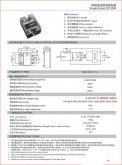UPDATE ~ Sorta !
Jason & I have been exchanging detailed email's in regards to the documentation I am reworking. Of course the Relays & the Delay board came up and with some back & forth, I lit a fire under him. Starting next week they will be doing their own testing on SSR's from a couple of companies, as well as Energy Saver Contactors as well. I've provided connections to a couple of manufacturers to him that seem to suit the needs.
Some background. Until Jan.2019 the Delay board did not exist, it was created to fill the need (use case) for EV applications. The fellow at AZLithium (who did the YT Video with the Nissan cells & the BMS16T) is the one who instigated it. Until that time, Chargery only recommended Relays and did not offer them as "additional optional components" but client demand had to be filled, so they went with Known Good reliable contactors that do the job, to address the need quickly. At that time SSR's were extremely expensive (still are in many cases) but that picture has changed considerably over the past year.
The Chargery BMS' are designed to meet all kinds of loads, Inductive, Capacitive and Resistive or others. As a result, it is difficult, even impossible to provide one or two solutions (use cases) to meet all of the varied requirements. The Delay Board is optional and may be helpful for pre-charging an Inverter depending upon the Inverter. The Delay board option is not an essential component, it's "need" is determined by the customer, although customers maybe don't know this, they have to consult their Inverter Documentation and/or other "load" devices to make this determination. The delay board was designed more for EV Support as the loading and operations are considerably different than for non-EV use.
-- Side Note... I am in contact with OEMS in regards to the SSR's and the Energy Saving Contactors and it will be a few days of back & forth before I have much information to share (also passing info up to Craig to help him in his testing too). The legwork is underway.
In closing a ponderance for folks. FAN's a big deal ? Seriously ! take 12VDC 100CFM box fan @ 0.015A (like those used in computers) the power draw is minimal. How many people leave an LED lightbulb on all day ? No matter what you do, there will always be some overhead with whatever gear you are using. For $3 a thermostatic control can be added so the fan only runs on set thresholds. We are not talking about 100W or even 10W LED Lights use between 3W-12W @ 120VAC. Don't get overly distracted with Minutia, you'll lose sight of the bigger picture. BTW, If you fear a relay draining your system will be the end of the universe, then maybe a rethink of what you are doing and how you are doing is warranted. Overhead Cost has to be built into the design of your solar system. If one has to nitpick, consider the Inverters at 85% efficiency versus those with 92% or higher efficiency, the less efficient inverters waste far more than any lame relay ! Pick you battle carefully and with wisdom.



